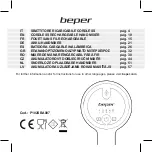
56
Chapter 4. Applying Effects to the Sound (Effects)
22. Feedback Pitch Shifter (Skew the Pitch)
fig.MFXFPS
This effect shifts the pitch of the original sound and layers it with the original sound. It can be used to play unison lines at an
interval of an octave or fifth, or to layer a slightly pitch-shifted with the original sound to create a chorus effect.
23. Reverb (Add Reverberation)
fig.MFXREV
This effect adds reverberation and ambiance to the sound, creating spatial depth.
Screen
Parameter
Explanation
Value
COARSE
(Coarse Pitch)
Specifies the amount of pitch shift relative to the original sound, in
semitone steps.
-24–12
X
FINE
(Fine Pitch)
Adjusts the amount of pitch shift in 2-cent steps.
-100–100
OUTPUT PAN
Determines the stereo location of the pitch-shifted sound.
L64–R63
PRE DELAY
(Pre Delay Time)
Specifies the time from the original sound until the pitch-shifted
sound is heard.
0.0–100
MODE
(Pitch Shifter Mode)
Specifies how the pitch will be shifted.As this setting is increased,
the response will be slower, but the sound will be more stable.
1–5
FEEDBACK
(Feedback Level)
Specifies the proportion of the pitch-shifted sound that will be fed
back into the input.
0–98 (%)
LOW GAIN
Adjusts the boost or cut of the low frequency range.
-15–15
HIGH GAIN
Adjusts the boost or cut of the high frequency range.
-15–15
BALANCE
(Effect Balance)
Specifies the volume balance between the original sound and the
pitch-shifted sound. When the setting is “0,” the pitch-shifted
sound will not be output.
0–100 (%)
Y
OUTPUT LEVEL
Specifies the output volume of the Feedback Pitch Shifter effect.
0–127
Screen
Parameter
Explanation
Value
TYPE
(Reverb Type)
You can select one of the follow-
ing six basic types of reverb.
ROOM1 (reverb with short decay and high density),
ROOM2 (reverb with short decay and low density),
STAGE1 (reverb with much subsequent reverberation),
STAGE2 (reverb with strong early reflections),
HALL1 (clear-sounding reverb),
HALL2 (rich-sounding reverb)
TIME
(Reverb Time)
Specifies the duration of the re-
verberation.
0–127
X
HF DAMP
Determines the frequency at
which the high frequency por-
tions of the reverberation will be
cut. As this parameter is set to a
lower frequency, more of the high
range will be cut, making the de-
lay sound more muted in tone. If
this “BYPASS” is selected, the
high frequency range will not be
cut.
200 (Hz)–8.00 (kHz), BYPASS
Summary of Contents for Groovebox D2
Page 113: ...MEMO ...
Page 114: ...MEMO ...
















































